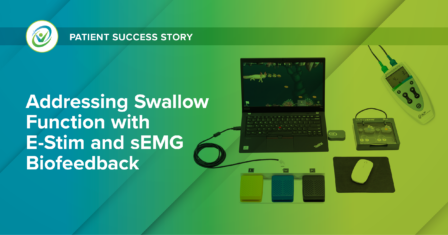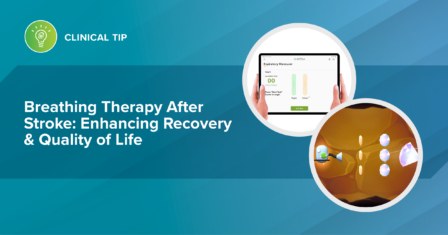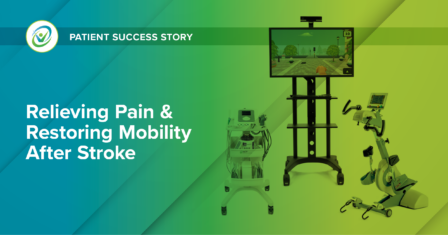Improving Functional Mobility with Dual-Task Training

In the early phase of rehab, a therapist may elect to challenge a patient with one task at a time. However, most functional activities in everyday life occur with two or more tasks performed at once. Individuals with neurologic disorders, advanced age, muscle weakness, or cardiopulmonary compromise commonly have deficits in their performance of motor and cognitive dual-tasks. Dual-tasking is defined as simultaneously performing two or more cognitive and/or motor tasks. DT training has been shown to offer the following therapeutic benefits:
- In older adults, DT training can improve balance and walking speed resulting in reduced fall risk. (Varela-Vàsquez et al., 2020)
- DT training in individuals with mild cognitive impairment, Parkinson’s disease, stroke, and multiple sclerosis has resulted in improved cognitive function, memory, physical performance, gait, and balance. (Pereira Olivia et al., 2020)
OmniFlow® can be used for inspiratory and expiratory muscle training

Dual-Task Training:
- Incorporate inspiratory muscle exercise (motor) while simultaneously utilizing Diamond Mine biofeedback activity (cognitive).
- Utilize expiratory muscle exercise (motor) while simultaneously performing Sail Away or Prehistoric Contest expiratory biofeedback activity (cognitive).
- Combine rhythmical breathing exercise (motor) with simultaneous performance of Starry Road biofeedback activity (cognitive).
OmniCycle® can be used for upper or lower extremity cycling therapeutic exercise

Dual-Task Training:
- Use biofeedback programs (i.e., Soccer, Bar Graph, Porcupine, Symmetry Road) to engage cognition and problem-solving.
- Engage the individual in conversation; have them tell a story or solve a riddle or math problem (cognitive) while cycling (motor).
- Have individual operate a cell phone or tablet (cognitive) while performing lower extremity cycling (motor).
OmniStand® provides dynamic support and can be used for ankle, hip, and stepping balance responses

Dual-Task Training:
- Instruct the individual to sing a song (cognitive) while marching (motor) in rhythm with the tune.
- Have individual operate a cellphone or tablet (cognitive) while performing standing balance (motor).
- Use the table top to play a game of cards or checkers (cognitive) while standing (motor).
- Alter leg and foot placement (motor) while catching a ball (motor).
OmniVR® can be used for sitting and standing balance, walking, and cognitive activities
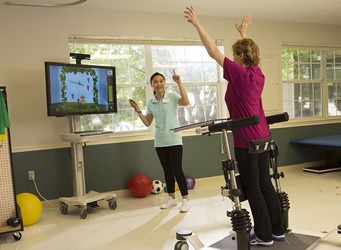
Dual-Task Training:
- Use the OmniVR® alone or in combination with the OmniStand® for balance training (motor) while simultaneously utilizing The Fox biofeedback activity to capture grapes (cognitive).
- Use gait activity (motor) while trying to step on a mole (cognitive) to improve forward/backward linear and diagonal gait patterns.
- Assess risk/safety awareness by identifying and prioritizing potentially hazardous situations using Everyday Environments biofeedback activity (cognitive) while simultaneously incorporating arm movement (motor) to select items.
OmniVersa®-PENS walk protocol can be used with standing, weight shifting, marching in place, or walking
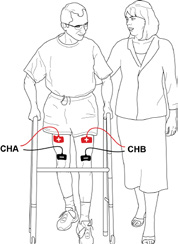
Dual-Task Training:
- Engage the individual in conversation (cognitive) while walking (motor) and ask questions or have them tell you something they did recently.
- Direct the individual to remove specific objects placed in his/her pockets (cognitive) while weight shifting (motor).
- Provide mental challenges; for example, “In 30 seconds, say as many words as you can that start with the letter R (cognitive) while marching in place (motor)”.
References:
Pereira Oliva, H. N., Mansur Machado, F. S., Rodrigues, V. D., Leão, L. L., & Monteiro-Júnior, R. S. (2020). The effect of dual-task training on cognition of people with different clinical conditions: An overview of systematic reviews. IBRO reports, 9, 24–31. https://doi.org/10.1016/j.ibror.2020.06.005
Varela-Vásquez, L. A., Minobes-Molina, E., & Jerez-Roig, J. (2020). Dual-task exercises in older adults: A structured review of current literature. Journal of frailty, sarcopenia and falls, 5(2), 31–37. https://doi.org/10.22540/JFSF-05-031
Authors:
Andreé Akst, PT, MPT, CEEAA, NASM-CES, Clinical Services Content Specialist
TOTM-00028
Latest Updates
Subscribe to stay up-to-date on our latest posts.

